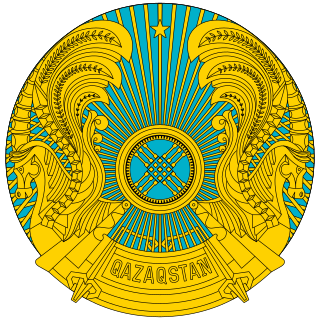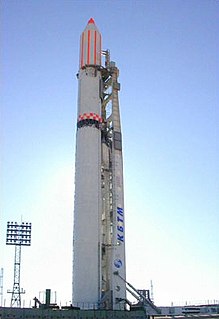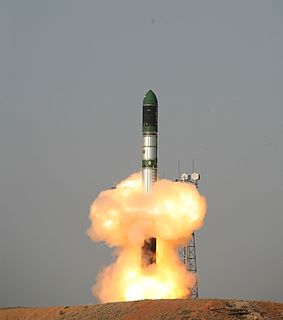| |||||
| Decades: | |||||
|---|---|---|---|---|---|
| See also: | |||||
The following lists events that happened during 2014 in Kazakhstan .
| |||||
| Decades: | |||||
|---|---|---|---|---|---|
| See also: | |||||
The following lists events that happened during 2014 in Kazakhstan .

The Commonwealth of Independent States (CIS) is a regional intergovernmental organization of nine members, plus two founding non-member, post-Soviet republics in Eurasia. It was formed following the dissolution of the Soviet Union in 1991. It covers an area of 20,368,759 km2 (7,864,422 sq mi) and has an estimated population of 239,796,010. The CIS encourages cooperation in economic, political and military affairs and has certain powers relating to the coordination of trade, finance, lawmaking, and security. It has also promoted cooperation on cross-border crime prevention.

Nursultan Ábishuly Nazarbayev, Kazakh pronunciation: [nʊrsʊlˈtɑn æbəɕʊˈlə nɑzɑɾˈbɑjɪf];. is a Kazakh politician currently serving as the Chairman of the Security Council of Kazakhstan who previously served as the first President of Kazakhstan, in office from 24 April 1990 until his formal resignation on 19 March 2019. He is one of the longest-ruling non-royal leaders in the world, having ruled Kazakhstan for nearly three decades. He was named First Secretary of the Communist Party of the Kazakh SSR in 1989 and was elected as the nation's first president following its independence from the Soviet Union. He holds the title "Leader of the Nation". In April 2015, Nazarbayev was re-elected with almost 98% of the vote, as he ran virtually unopposed.

The Government of the Republic of Kazakhstan oversees a presidential republic. The President of Kazakhstan, currently Kassym-Jomart Tokayev, is head of state and nominates the head of government. Executive power is exercised by the government. Legislative power is vested in both the government and the two chambers of parliament.

Plesetsk Cosmodrome is a Russian spaceport located in Mirny, Arkhangelsk Oblast, about 800 km north of Moscow and approximately 200 km south of Arkhangelsk, the cosmodrome dates from 1957. Originally developed as an ICBM site for the R-7 missile, it also served for numerous satellite launches using the R-7 and other rockets. Its high latitude makes it useful only for certain types of launches, especially the Molniya orbits, so for much of the site's history it functioned as a secondary location, with most orbital launches taking place from Baikonur, in the Kazakh SSR. With the end of the Soviet Union, Baikonur became a foreign territory, and Kazakhstan charged $115 million usage fees annually. Consequently, Plesetsk has seen considerably more activity since the 2000s.

Zenit is a family of space launch vehicles designed by the Yuzhnoye Design Bureau in Dnipro, Ukraine, which was then part of the Soviet Union. Zenit was originally built in the 1980s for two purposes: as a liquid rocket booster for the Energia rocket and, equipped with a second stage, as a stand-alone middle-weight launcher with a payload greater than the 7 tonnes of the Soyuz but smaller than the 20 tonnes payload of the Proton. The last rocket family developed in the USSR, the Zenit was intended as an eventual replacement for the dated Soyuz and Proton families, and it would employ propellants which were safer and less toxic than the Proton's nitrogen tetroxide/UDMH mix. Zenit was planned to take over crewed spaceship launches from Soyuz, but these plans were abandoned after the dissolution of the Soviet Union in 1991.

The Dnepr rocket was a space launch vehicle named after the Dnieper River. It was a converted ICBM used for launching artificial satellites into orbit, operated by launch service provider ISC Kosmotras. The first launch, on April 21, 1999, successfully placed UoSAT-12, a 350 kg demonstration mini-satellite, into a 650 km circular Low Earth orbit.
The Eurasian Economic Community was a regional organisation between 2000 and 2014 which aimed for the economic integration of its member states. The organisation originated from the Commonwealth of Independent States (CIS) on 29 March 1996, with the treaty on the establishment of the Eurasian Economic Community signed on 10 October 2000 in Kazakhstan's capital Astana by Presidents Alexander Lukashenko of Belarus, Nursultan Nazarbayev of Kazakhstan, Askar Akayev of Kyrgyzstan, Vladimir Putin of Russia, and Emomali Rahmon of Tajikistan. Uzbekistan joined the community on 7 October 2005, however later withdrew on 16 October 2008.

Adilbek Ryskeldiuly Zhaqsybekov is current Head of the Executive Office of the President of the Republic of Kazakhstan. He served as the minister of defence from June 2009 to April 2014. He was the head of Kazakh President Nursultan Nazarbayev's administration. He served as the Mayor of Astana from 1997 to 2003 and from 2014 to 2016. Chairman of Governors of the Islamic Development Bank in 2003, and the Minister of Industry and Trade from 2003 to 2004.

The United States and the Republic of Kazakhstan established diplomatic relations on December 16, 1991. The United States opened its embassy in Almaty in January 1992 and then relocated to Nur-Sultan in 2006.

Soyuz-2 is a modernised version of the Russian Soyuz rocket. In its basic form, it is a three-stage launch vehicle for placing payloads into low Earth orbit. Compared to the previous versions of the Soyuz, the first-stage boosters and two core stages feature uprated engines with improved injection systems. Digital flight control and telemetry systems allow the rocket to be launched from a fixed launch platform, whereas the launch platforms for earlier Soyuz rockets had to be rotated as the rocket could not perform a roll to change its heading in flight.

The Soyuz-FG launch vehicle was an improved version of the Soyuz-U from the R-7 family of rockets, designed and constructed by TsSKB-Progress in Samara, Russia. Guidance, navigation, and control system was developed and manufactured by "Polisvit" Special Design Bureau.

Gagarin's Start, also known as Baikonur Site 1 or Site 1/5 is a launch site at Baikonur Cosmodrome in Kazakhstan, used for the Soviet space program and now managed by Roscosmos.

The Vostochny Cosmodrome is a Russian spaceport above the 51st parallel north in the Amur Oblast, in the Russian Far East. It is intended to reduce Russia's dependency on the Baikonur Cosmodrome in Kazakhstan. The first launch took place on 28 April 2016 at 02:01 UTC. As of July 2019, five launch attempts have been made with four successes.

Kazakhstan–Russia relations refers to bilateral foreign relations between Kazakhstan and the Russian Federation. Kazakhstan has an embassy in Moscow, a consulate-general in Saint Petersburg, Astrakhan and Omsk. Russia has an embassy in Nur-Sultan and consulates in Almaty and Oral. Nur-Sultan and Moscow are military and political allies.

The Eurasian Economic Union (EAEU) is an economic union of states located in Eastern Europe, Central Asia and Western Asia. The Treaty on the Eurasian Economic Union was signed on 29 May 2014 by the leaders of Belarus, Kazakhstan and Russia, and came into force on 1 January 2015. Treaties aiming for Armenia's and Kyrgyzstan's accession to the Eurasian Economic Union were signed on 9 October and 23 December 2014, respectively. Armenia's accession treaty came into force on 2 January 2015. Kyrgyzstan's accession treaty came into effect on 6 August 2015. It participated in the EAEU from the day of its establishment as an acceding state.
The National Space Agency of the Republic of Kazakhstan, also known as KazCosmos, or KazKosmos, is Kazakhstan's national space agency, and was officially established on 27 March 2007.

EgyptSat 2 was Egypt's second remote sensing Earth observation satellite. It was built by the Russian RSC Energia and the Egyptian NARSS while the incorporated cameras and payload was developed by OAO Peleng and NIRUP Geoinformatsionnye Sistemy in Belarus.
Events in the year 2018 in Kazakhstan.
EgyptSat-A or MisrSat A is Egypt's third Earth observation satellite following the EgyptSat 1 launched in 2007 and EgyptSat 2 launched in 2014. This satellite was built by the Egyptian National Authority for Remote Sensing and Space Sciences Jointly with Russian RKK Energia while the imaging payload was developed by OAO Peleng and NIRUP Geoinformatsionnye Sistemy in Belarus.
The space program of Kazakhstan is originated from the dissolution of the Soviet Union in 1991, when Kazakhstan declared their independence. The Kazakh space program consist of cosmonaut and satellite missions. The only launch site situated at Kazakhstan is Baikonur Cosmodrome, which is leased to Russia. The program is led by KazCosmos since 2007.